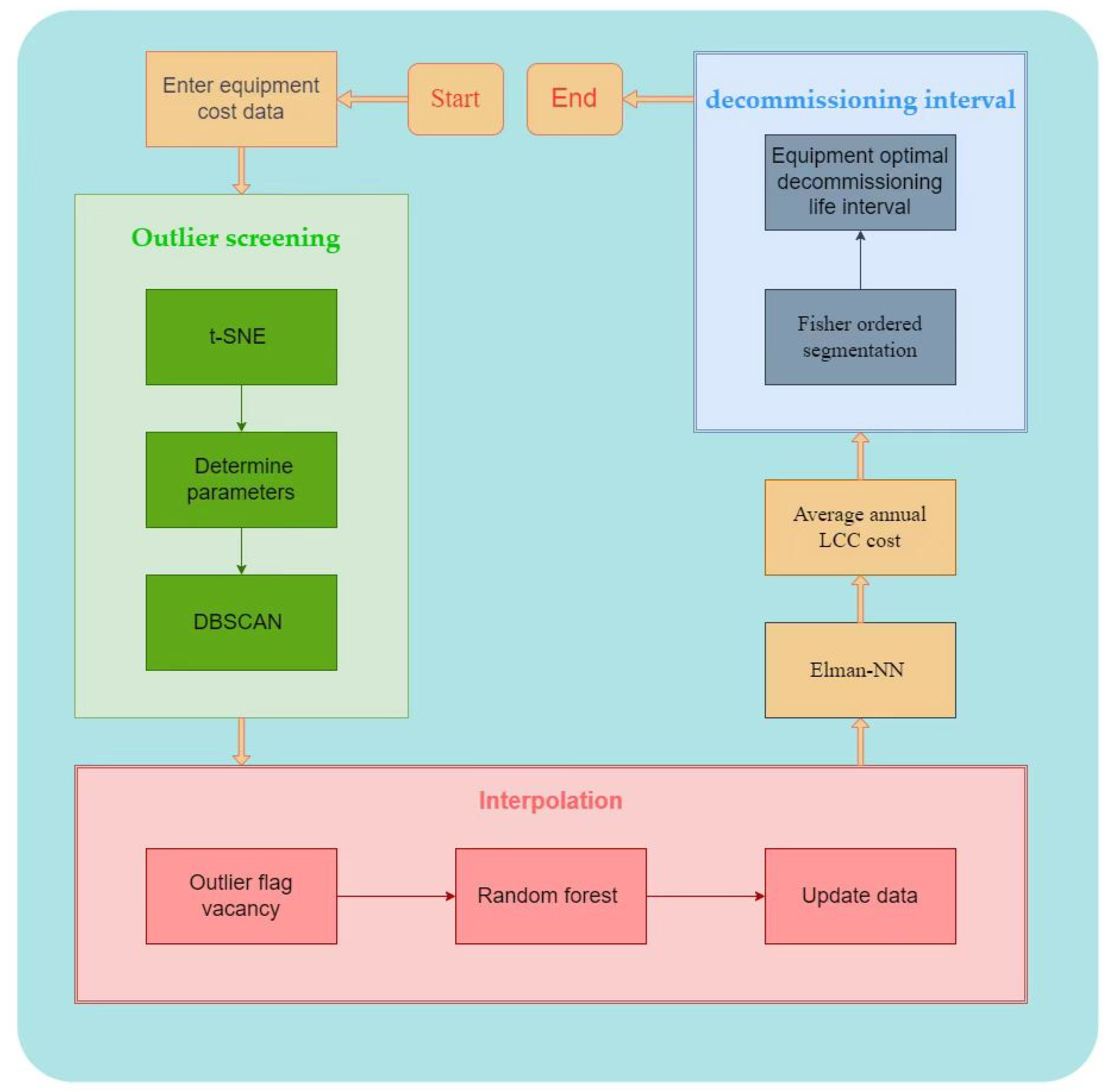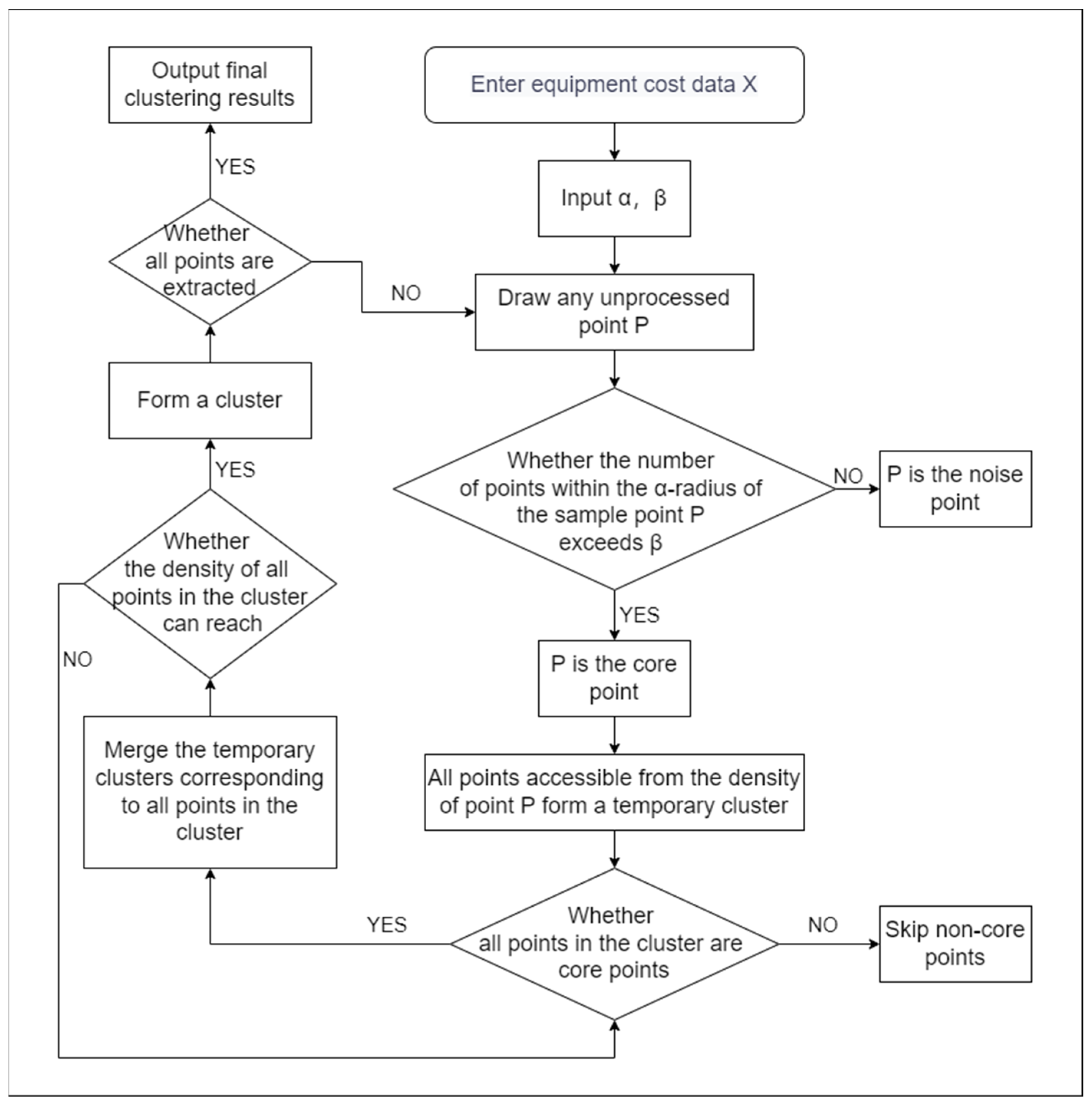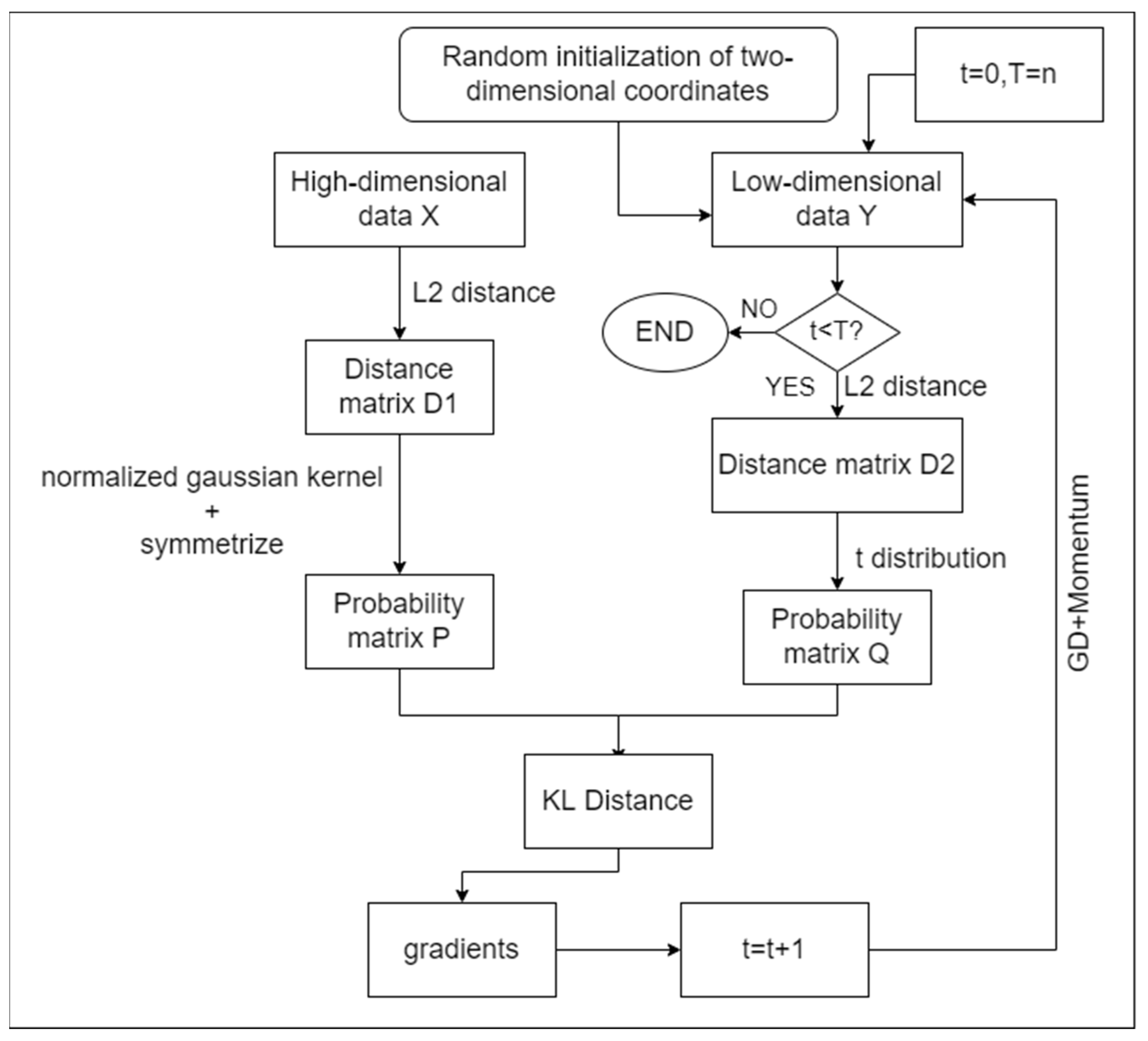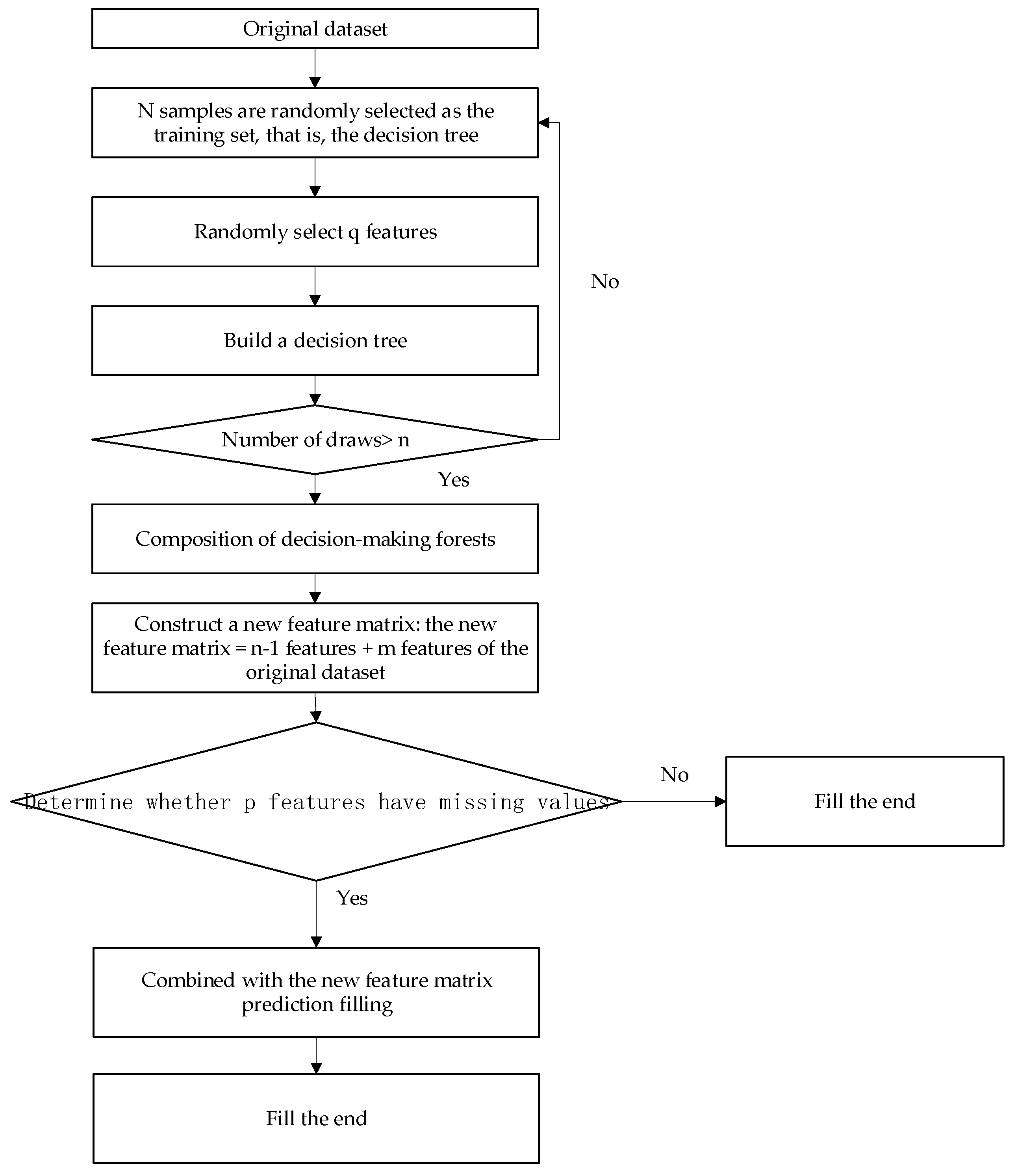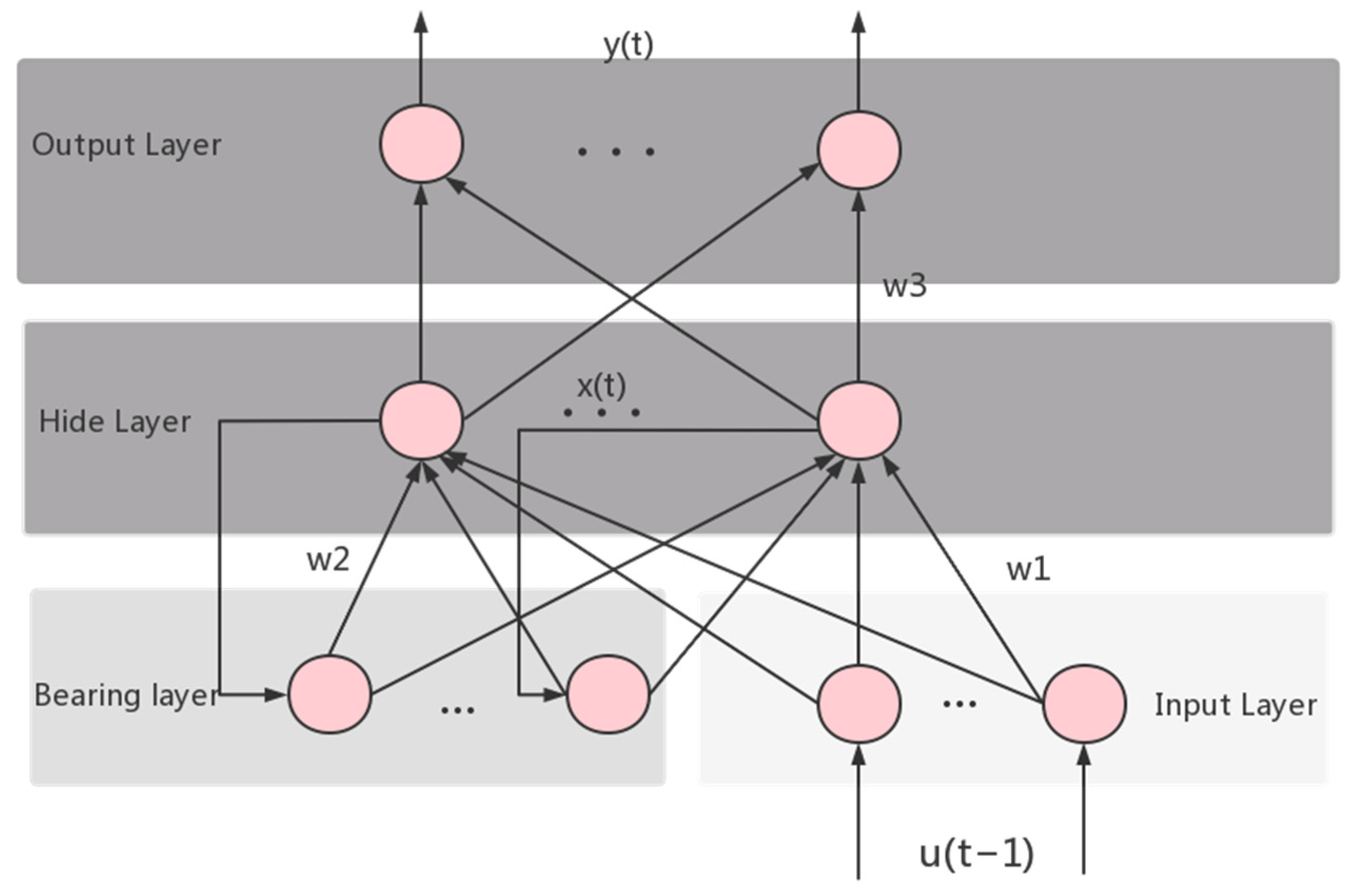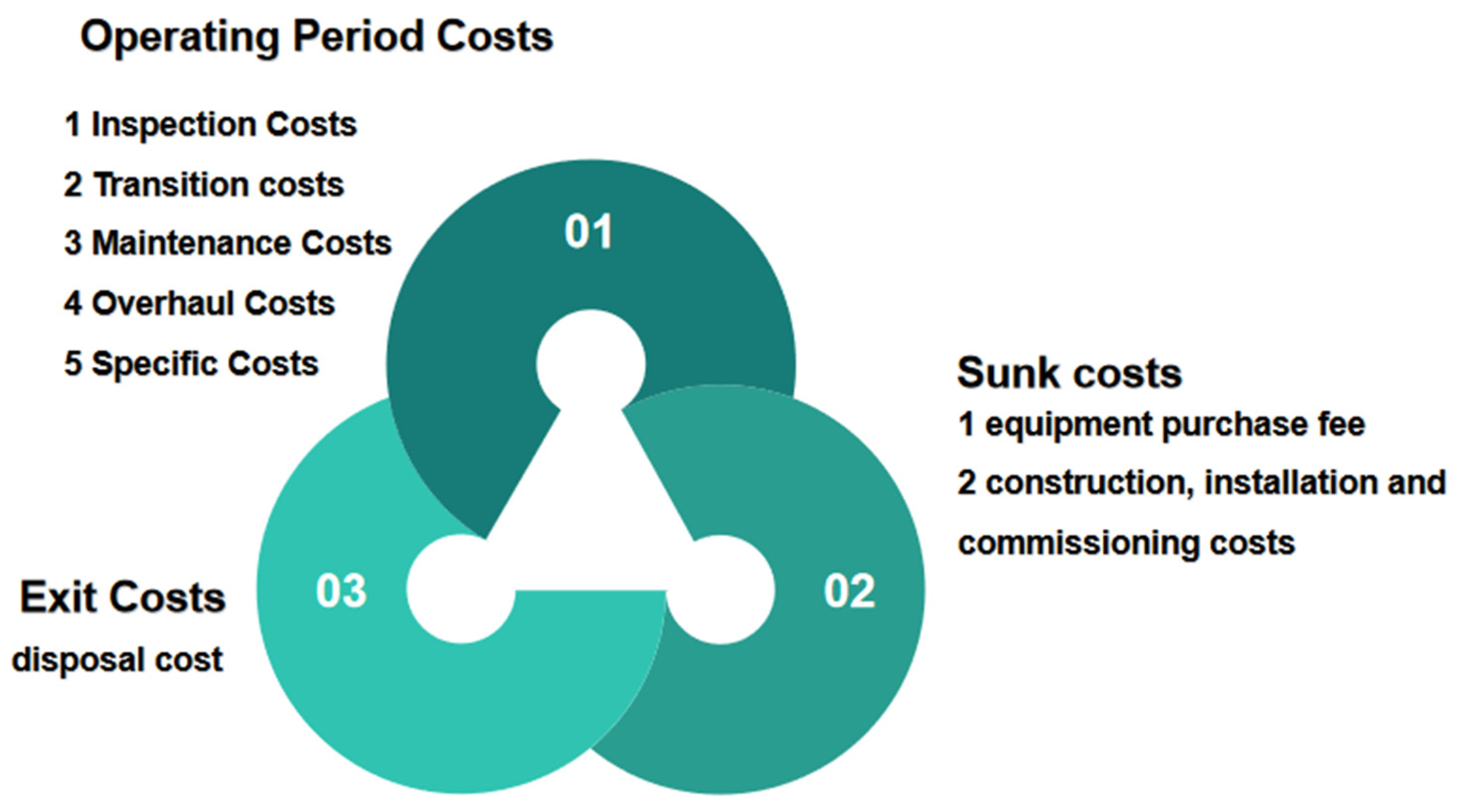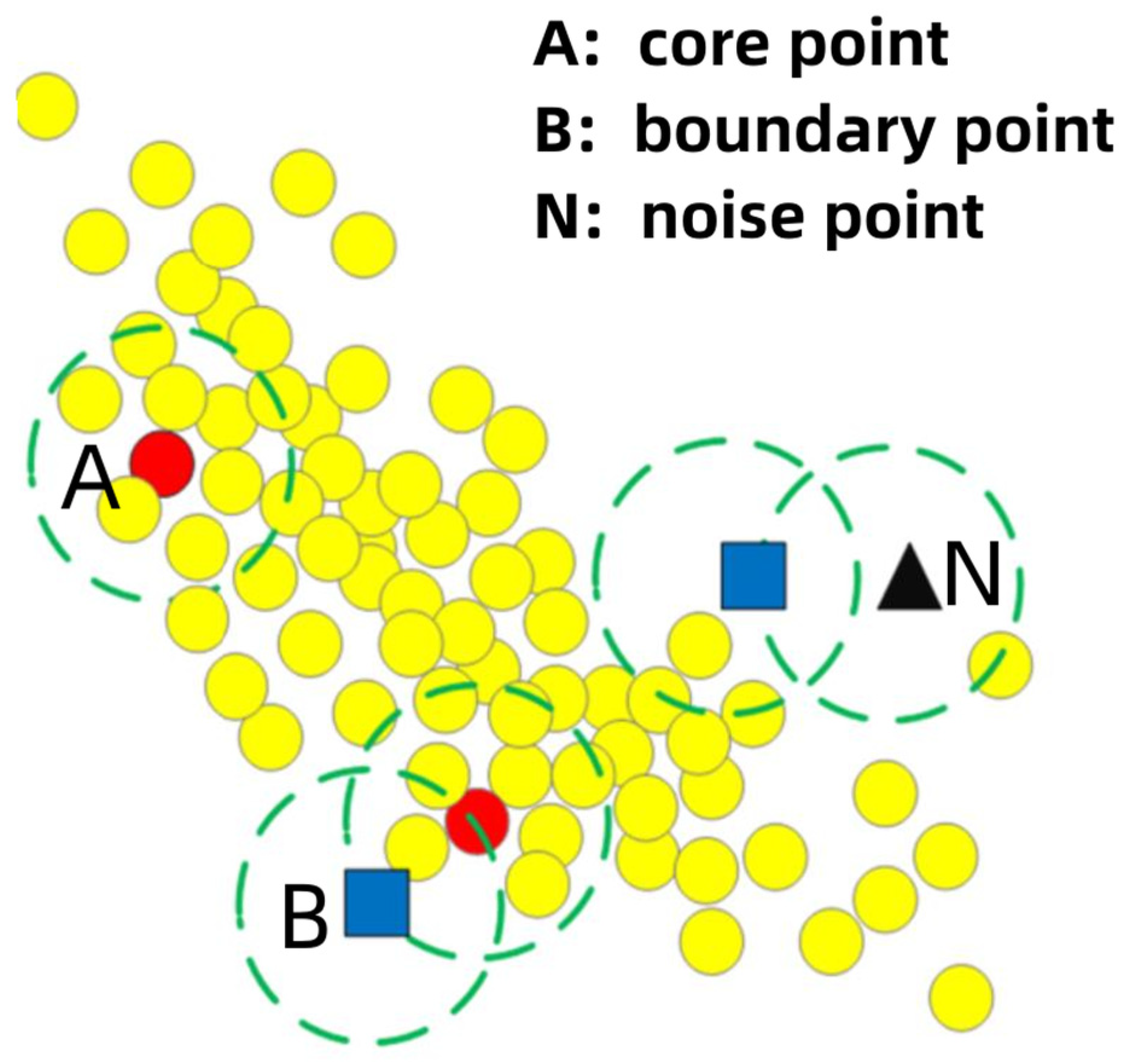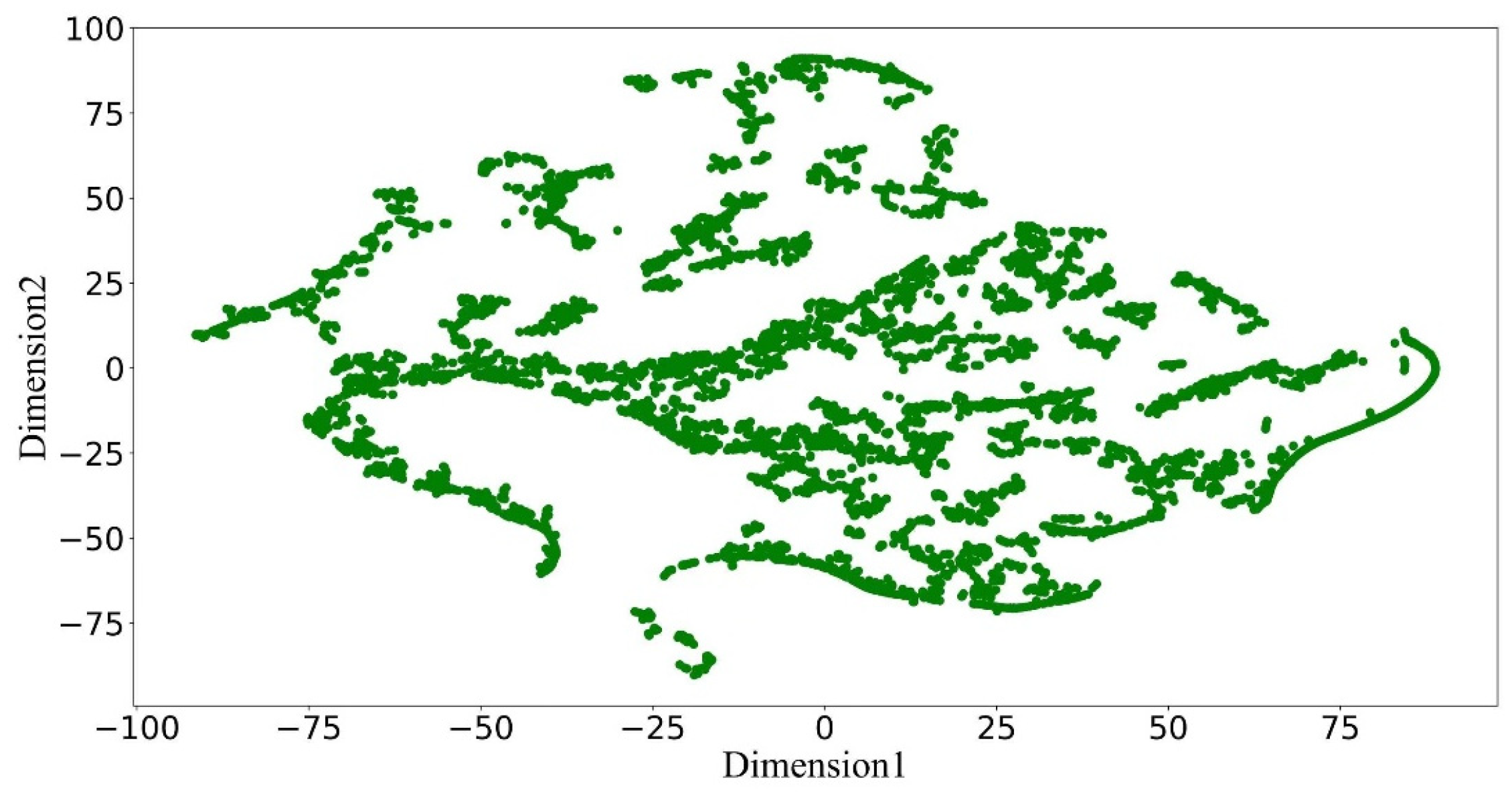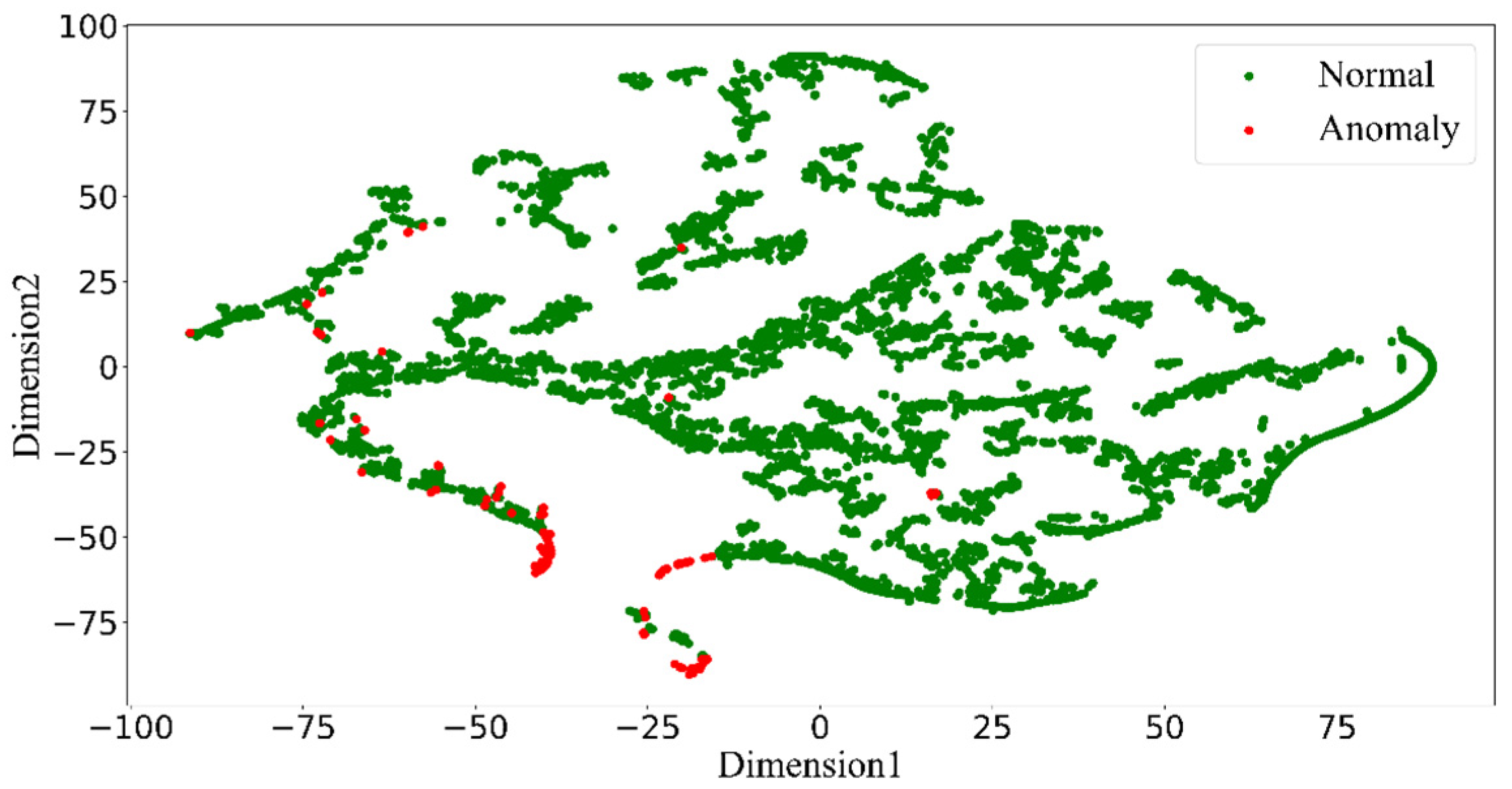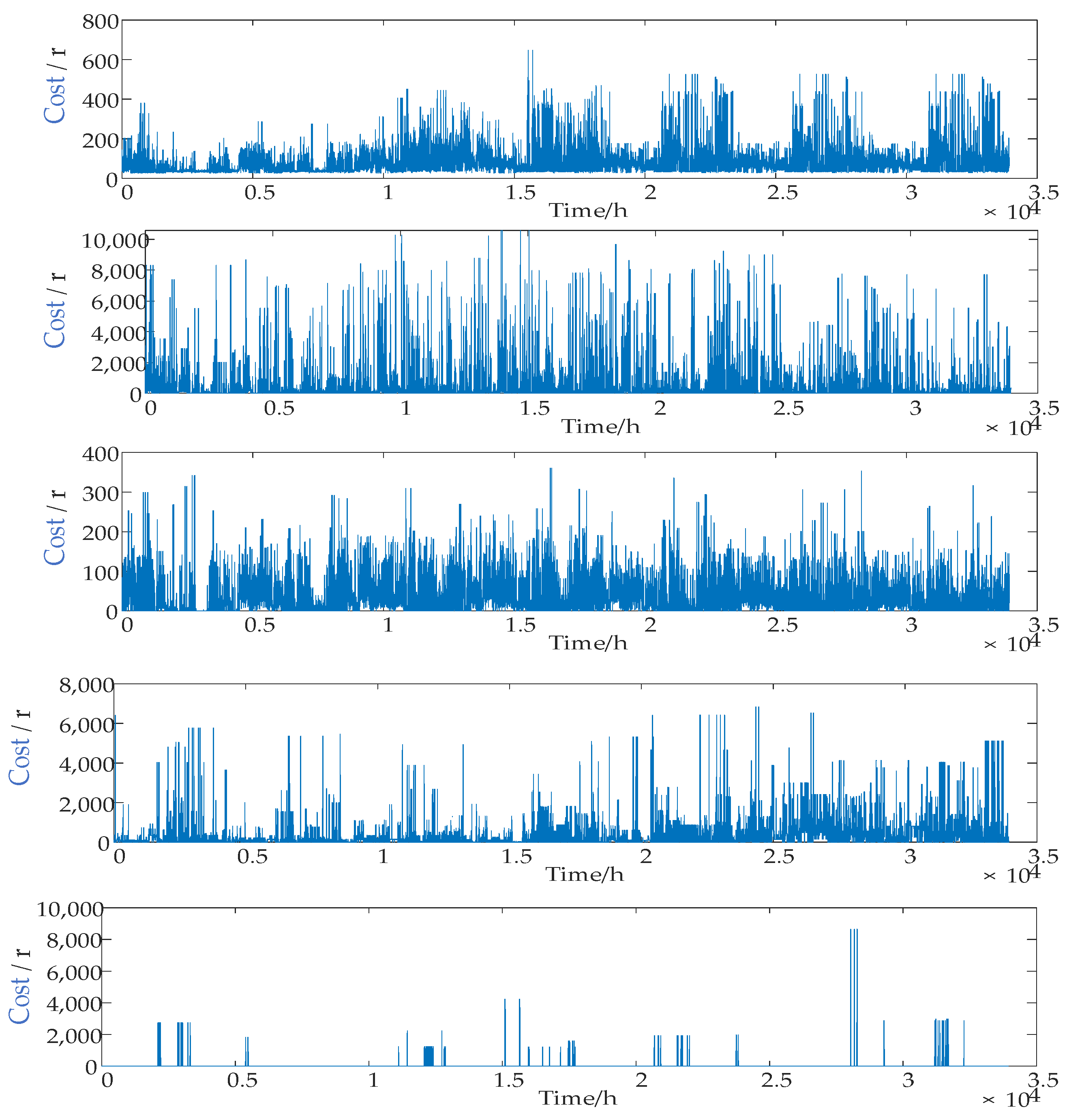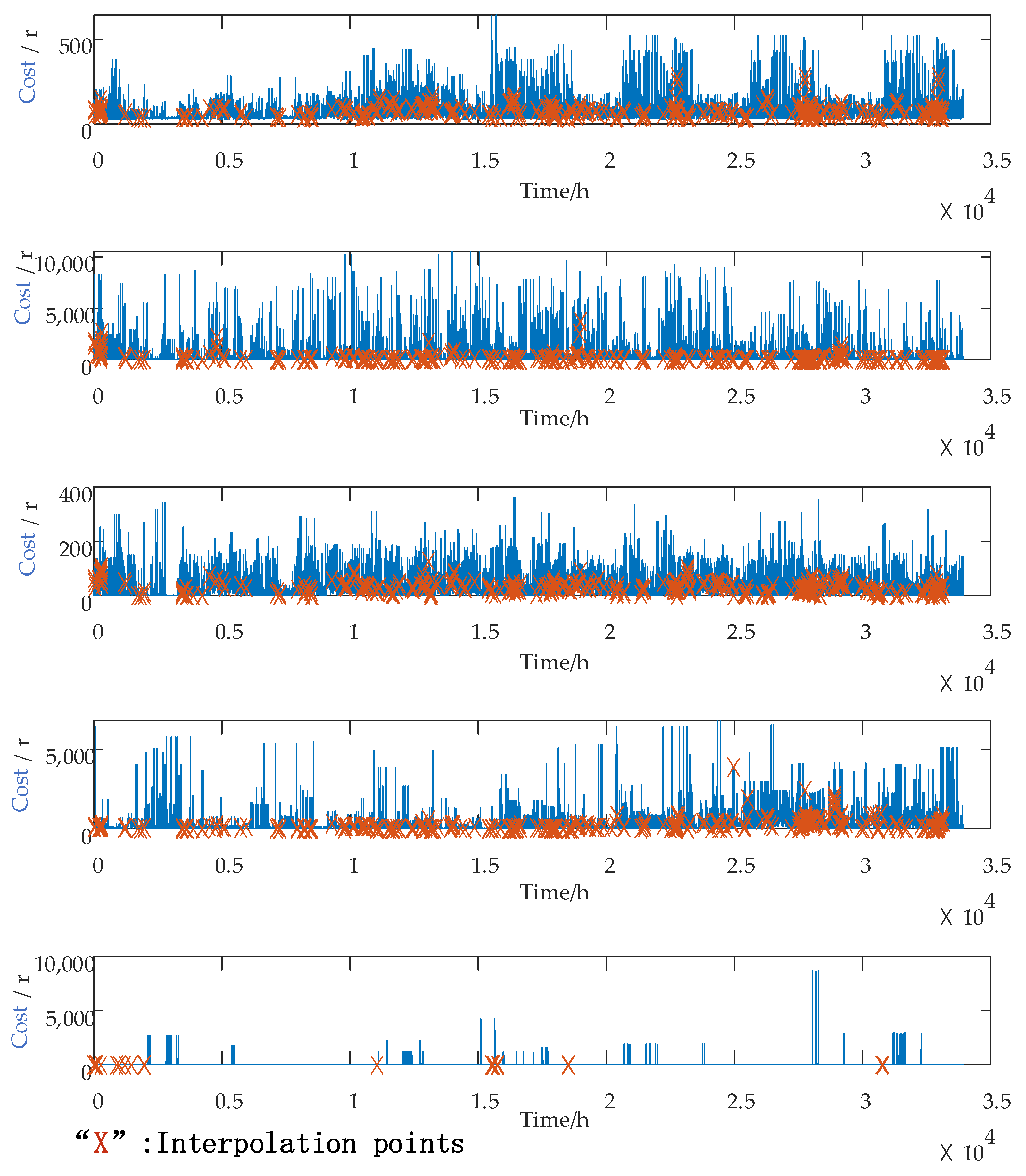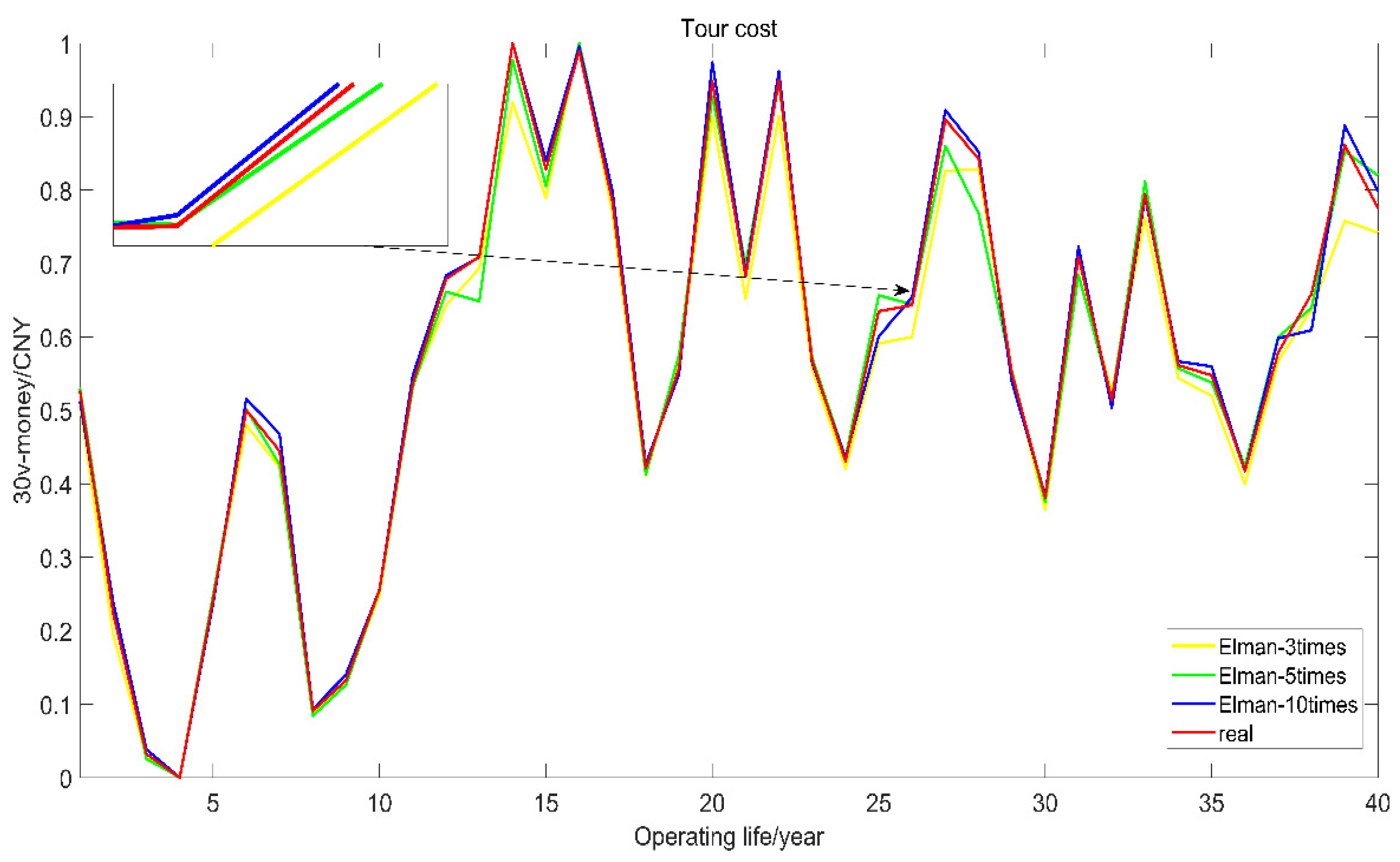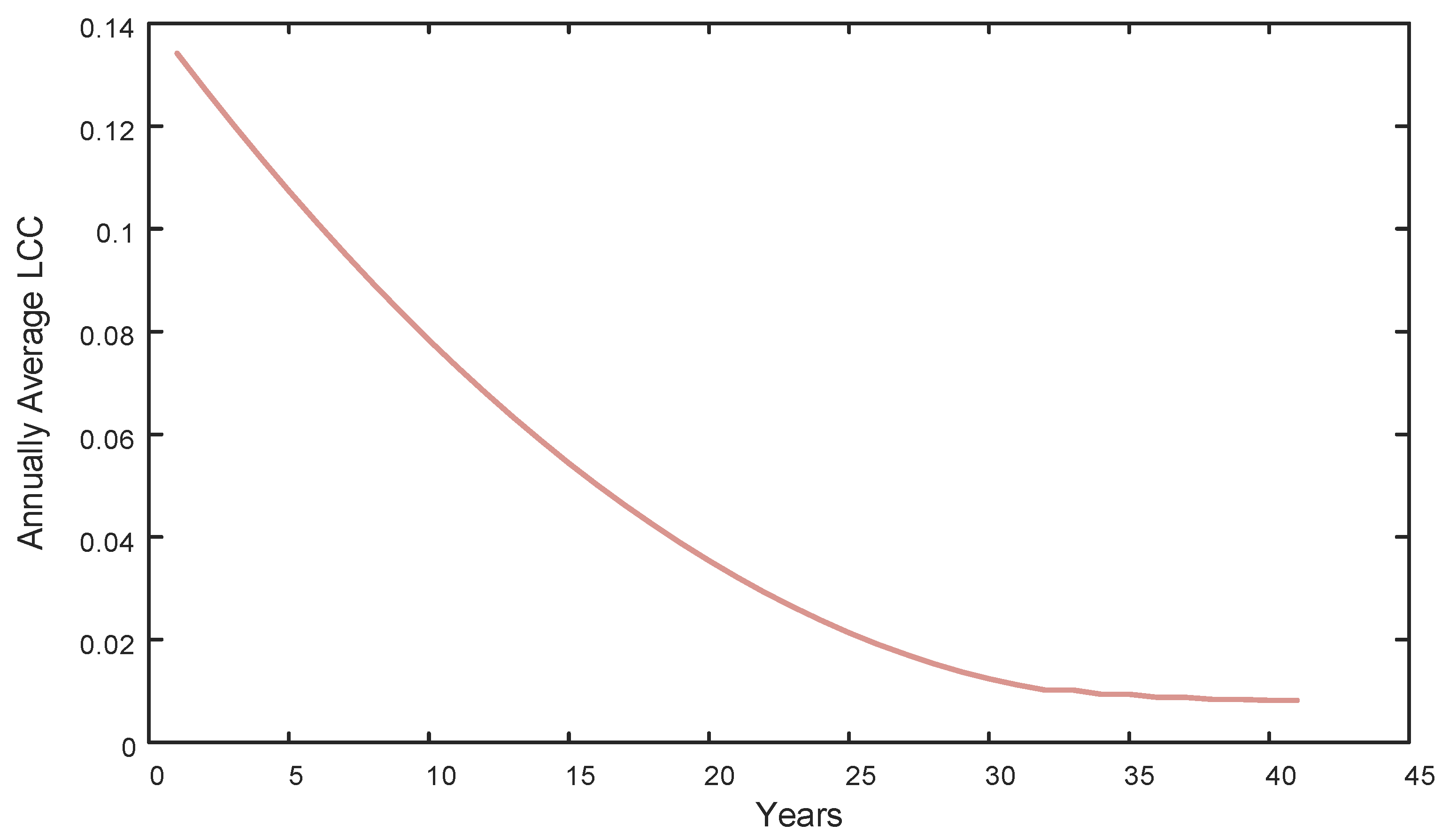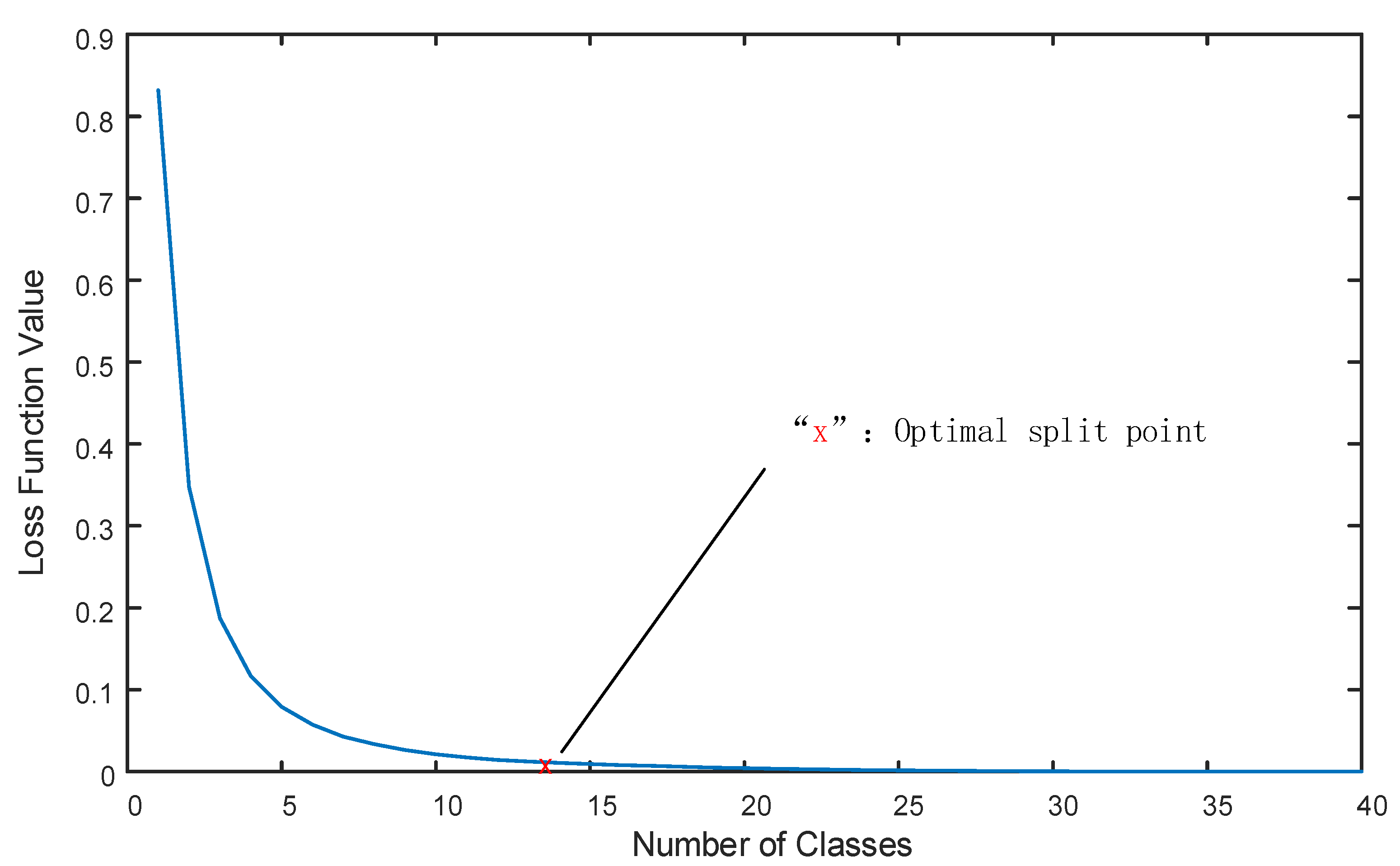1. Introduction
With the development of the
economy, people are consuming more and more energy, and energy supply is gradually decreasing. In order to solve the energy problem, many scholars have conducted research to reduce the waste of energy and optimize the operation of equipment. Jinlong Liu (2018) [
1] detailed an optical investigation of flame luminosity inside a conventional heavy-duty diesel engine converted to spark the ignition of the natural gas operation by replacing the diesel fuel injector with a spark plug and adding a port-fuel gas injector in the intake manifold. Jinlong Liu (2023) et al. [
2]
pointed out that diesel engine performance degraded non-linearly with increasing altitude and soot is more sensitive to altitude than other combustion-related parameters. Meiyao Sun,
Zhentao Liu (2023) et al. [
3]
proposed that the heat exchange of the intercooler fluctuated less with altitude under variable speed conditions, which may benefit the design and optimization of high-altitude engines and turbocharged systems. Dongli Tan,
Yao Wu (2023) et al. [
4]
improved the
3D model, chemical kinetics mechanism were developed, and the performance optimization was carried out by the response surface methodology. In order to optimize the fuel injection strategy in the combustion process of oxygenated fuel, Dongli Tan (2023) et al. [
5] adopted the orthogonal experimental design to optimize the timing of pre-injection fuel and the mass ratio of pre-injection fuel, and determined their best combination, which contributed to the mitigation of energy and environmental crisis. In order to better develop new energy sources, Yagang Zhang et al. (2022) [
6] adopted a model based on the Monte Carlo and artificial intelligence algorithms to establish a comprehensive wind speed prediction system, and proposed a new method for processing the wind speed error sequence. Over the past years, the optimization of the enterprise management strategy has attracted widespread attention and has become the focus of discussion among many scholars. As companies grow and acquire equipment on an increasingly large scale, it is imperative to optimize the management strategy of the equipment.
The entire life-cycle cost (LCC) of equipment studies the costs incurred from the purchase of equipment until its decommissioning. The entire life-cycle cost depends on the service life of the equipment, so it is crucial to decide the optimal life of the equipment to be taken out of service in order to reduce the cost investment and make full use of the capital.
In order to help enterprises optimize the management strategy of equipment and reasonably allocate the capital investment of equipment, more and more scholars are studying the LCC so as to control the cost and optimize the capital allocation. For example, Li Tao et al. (2008) [
7] established an LCC model for substation equipment based on the LCC
theory and split the costs related to the whole process of substation equipment operation. Gandhi JJ et al. (2017) [
8] considered the later operation and maintenance costs based on the upfront investment cost of equipment, and selected the best solution based on the net present value of power generation and generation cost based on the
LCC analysis. The first-rate solution was selected on the basis of the net present value and generation cost. Zhang Yong and Wei Cellophane (2008) [
9] proposed that grid enterprises should carry out the thinking of the whole-life cycle management of assets in view of the problems faced by traditional power enterprises, which effectively solved the problems in the traditional management mode. Under the assumption of the safe and reliable operation of the power grid, the lowest cost of the whole-life cycle of assets
came true. Liu Youwei (2012) [
10] took power transformers as an example based on the LCC model by comparing the maximum annual net benefits under two cases of overhaul and
replacement, and made the decision of whether to apply overhaul or replacement. Liu, Kai (2006) [
11] used techno-economic analysis to determine the economic life of the equipment, and after considering the objective existence of the time value of money, chose the dynamic model analysis to calculate the economic life of the equipment. In order to calculate a more scientific and accurate LCC, some scholars have made an improvement.
Guilin Zou (2021) [
12] adopted the membership function method based on fuzzy logic to improve the allocation and make the LCC model more scientific and reasonable. Xu Chong (2010) [
13] proposed to establish a decision support system suitable for LCC management while affirming the LCC model, using engineering calculation methods and artificial intelligence algorithms to provide more accurate data for the LCC model. Jianpeng Bian (2014) [
14] proposed a new LCC model based on probability on the basis of previous studies on LCC and proved the practicability of the probabilistic LCC model on power transformers. Compared with the traditional LCC model, it is more reasonable, more economical, and more effective. The LCC of equipment is related to the service life, and determining the appropriate equipment decommissioning life is also beneficial to the optimization of management strategy, especially the technical overhaul strategy. Most companies use the design life of the equipment as the retirement life, but some scholars have conducted studies on the retirement life and selected the economic life as the retirement life. For example, Wu Guiyi et al. (2014) [
15] established a mathematical model for the economic life assessment of high-voltage circuit breakers with the minimum annual average LCC as the objective function by combining LCC theory. Wang Shiming (2018) [
16] assessed the economic life of protection devices to determine the optimal retirement time ground on the theory of total life cycle management, which allows power companies to improve the management of secondary equipment such as protection devices.
The Elman neural network is a feedback neural network with an input layer, hidden layer, intermediate layer, inheriting layer,
and output layer. It has a good memory of historical data and strong adaptability to abrupt data. Considering the randomness of equipment failure, this paper uses the Elman neural network to conduct a sampling simulation on cost data sets instead of a simple averaging process. The Elman neural network is widely used and has been studied by many scholars. Li Chao et al. (2023) [
17] used the Elman neural network to predict the time series of wind speed in different regions of the country, proving the feasibility of neural networks in wind speed prediction. Zhu Qinyue et al. (2023) [
18] used the actual output voltage data of the inverter to identify the input parameters of the Elman neural network in order to extract the IGBT micro fault features of the multi-mode output voltage of the
inverter, and trained and tested the data to realize the division of different working modes. Kong et al. (2022) [
19] used the Elman neural network to train the absorbance data of filtrate, pure formation water and mixed fluid, predicted the absorbance of pure formation water, and calculated the pollution rate of formation water by combining the absorbance of filtrate of drilling fluid collected in the initial stage of pumping. In order to solve the problem of the difficult location of short-circuit faults in the 10 kV distribution network, Gao Yiwen et al. (2022) [
20] used the data of the short-circuit fault diagnosis feature database of the distribution network as the data input of the Elman neural network, and achieved fuzzy matching between multi-source data and the type and location of short-circuit faults in the distribution network through data training, and subsequently, verified the feasibility of this model with examples. Cui Xinyuan et al. (2022) [
21] took the “weather-power” sample data as the input data of the Elman neural network and conducted the training. Then, CGABC was used to optimize the connection weight of the Elman neural network. In addition, some scholars have proposed other optimization models for prediction. For example, Yagang Zhang et al. (2022) [
22] proposed a hybrid wind power generation prediction system. Firstly, the energy entropy theory was used to determine the number of VMD decomposition and solve the problem of the overdecomposition of VMD. Secondly, sample entropy is used to identify the complexity of eigenmodes, and different prediction methods are applied to predict EVMD. In addition, the grey wolf optimizer was improved to optimize the parameters of the prediction method. Finally, on the basis of kernel density estimation, noise signal obtained by EVMD was used to construct a prediction interval.
Through combing the literature, it was found that few scholars have conducted research on the decommissioning life of equipment, and there are some shortcomings, such as not considering the different failure rates of equipment when calculating the cost of equipment, not optimizing the data set before analysis, and selecting a single decommissioning life. In order to calculate the optimal decommissioning life of the equipment, this paper takes the 35 kV voltage transformer of an electric power enterprise as the research object, extracts all the costs to form a data set; firstly, t-SNE is used to reduce the dimension of the data and determine the distribution information of the data, and DBSCAN is used to screen the cost data set for outliers, and the screened outliers and the vacant values of the data set itself are interpolated by a random forest algorithm to achieve the purpose of correcting the data set; then, the Elman neural network is used for random simulation to obtain the annual average LCC cost of equipment, and finally, the Fisher-ordered partitioning is used to find the interval of the decommissioning life. In this paper, firstly, the data are screened and filled with outliers to make the data more reasonable and avoid the anomalies caused by registration errors and so on. Due to the different probabilities of equipment failure, the Elman neural network was used for stochastic simulation to simulate the randomness of equipment failure. In order to make the calculated equipment life more scientific and reasonable,
Fisher-
ordered partitioning was used to find out the interval of the decommissioning life, which is convenient for enterprises to choose the equipment decommissioning time according to their actual operation situation. We generalize the above model as the
Life Cycle Cost–t-SNE–DBSCAN–Elman–Fisher model (LC–TD–EF model). The optimal decommissioning life of the equipment calculated using the LC–TD–EF model is more scientific, which not only ensures the safety and stability of the equipment during the operation period, but also takes into account the efficiency of the enterprise’s capital utilization, avoids the waste of capital, and at the same time gives the enterprise the independent choice to choose the decommissioning life of the equipment according to the operation situation, and to choose the earlier or later decommissioning. The article process is shown in
Figure A1.
2. Materials and Methods
2.1. The Constitution of the Life Cycle Cost–t-SNE–DBSCAN–Elman–Fisher Model
In order to obtain the optimal decommissioning life of the energy enterprise equipment, the LC–TD–EF model is proposed. The LC–TD–EF model consists of a variety of algorithms, each of which plays a different role. To make the data set more convenient for subsequent calculation, t-SNE is first used to reduce the data dimension and determine the data distribution. Then, DBSCAN is used to filter the data outliers and mark the abnormal data as vacancy value after filtering. The gap of cost data is unreasonable. In order to make up for the gap of data, a random forest algorithm is used for interpolation. After testing, the degree of data dispersion after interpolation is significantly improved, and subsequent processing will be expanded based on the complete data after interpolation. Considering the randomness of equipment failure, it is unreasonable to average cost data in the whole-life-cycle costing process. In this model, the Elman neural network is used to sample data and random simulation instead of a simple averaging process. The economic life is the service life of the equipment corresponding to the lowest annual average life-cycle cost, but it will no longer be used when the average life-cycle cost curve of the year is in a continuous downward trend. Therefore, this model uses Fisher order segmentation to calculate the decommissioning life interval of the equipment, and the equipment is decommissioned in the obtained interval, which satisfies both “safety” and “economy”.
2.2. The Entire Life Cycle Cost
The LCC takes into account the entire process of equipment, from initial purchase to intermediate operation to final disposal. LCC is more scientific and reasonable than other cost theories, and is, therefore, widely used in various industrial fields. The LCC model is formed by decomposing and modeling the cost of equipment, and there are various LCC models based on the different realities and data in each field. However, in general, LCC models are divided into the following parts: sunk costs, operating costs and exit costs. The traditional LCC model has certain shortcomings and some scholars have improved it. Lee Han et al. (2013) [
23] predicted the investment cost and maintenance cost of different transmission equipment and evaluated the LCC in terms of economics and durability. Wang Mianbin (2020) [
24] used the techno-economic theory and interval method, considered the operating cost uncertainty risk factors, and constructed a whole-life economic life optimization model for transmission line projects, instead of the previous list trial algorithm, which improves the measurement efficiency and has stronger operability. Lu Liu (2010) [
25] combined the association between each element on the basis of the traditional LCC theoretical model and proposed a two-dimensional LCC model dividing the LCC cost into the equipment layer and the system layer with the advantages of considering that Mingxin Zhao (2012) [
26] proposed a new model, a whole-life-cycle cost model based on risk estimate, based on the traditional LCC approach. The equipment takes into account the risk and with the help of the risk estimate theory, the equipment value of the entire system can be assessed, and the use of this model in the real distribution network can comprehensively assess the hazard of the equipment and make the decision more economical. With the development of artificial intelligence algorithms, more scientific and reasonable algorithmic models are starting to be incorporated into the LCC model. Huifang Wang (2015) [
27] classified and extracted key data from the whole-life data of transformers, and used a distribution-free proportional failure rate model and a Monte Carlo simulation to calculate the probability distribution of failure rate and downtime duration, which provided more accurate data for the whole-life cost model. Sung Hun Lee (2012) [
28] verified the scientific validity and superiority of the sensitivity analysis method after establishing the entire life-cycle-cost model for power transformers, and conducted sensitivity analysis on the entire life-cycle-cost model for transformers to obtain cost factors that have a significant impact on the LCC model.
In summary, the LCC administration is not a requirement for the local Pareto optimum but a systematic and global overall optimum, and its pursuit is to maximize economic benefits, which is essentially a systematic management concept.
2.3. Economic Life
Economic life is an economic concept that focuses on determining the optimal service life of equipment or assets. In the field of power equipment, the average purchase cost of a device will decrease with an increase in service life, as the purchase cost remains constant. This means that the economic benefits will increase as the service life of the equipment increases. However, as the equipment becomes older, the annual maintenance and repair costs may increase, leading to a potential decrease in economic benefits with an increase in service life. The average annual total cost (including purchase, operation, and maintenance costs) may show a trend of decreasing first and then increasing. The definition of economic life refers to the period within which the average annual total cost of a device is minimized. This concept involves complex factors such as technical conditions, market demands, and maintenance costs. Technical conditions are an important factor in determining economic life, as technological updates may render older devices unable to meet current market demands, thereby shortening their service life. In addition, maintenance costs are also a critical factor in determining economic life, as maintenance and repair costs tend to increase as equipment ages, and may require timely updates to extend service life. Therefore, determining economic life requires a multidisciplinary approach that combines knowledge from economics, management, and engineering to conduct comprehensive analysis and decision-making.
2.4. Density-Based Spatial Clustering of Applications with Noise
DBSCAN is an unsupervised density-based clustering algorithm based on high-density connected regions, capable of dividing high-density regions into clusters and classifying outliers as outliers, thus achieving the purpose of screening outliers. Compared with other common clustering methods, the DBSCAN clustering algorithm can discover clusters of arbitrary shapes in the sample space, not limited to spheres, without inputting the number of clusters to be divided. Therefore, DBSCAN has been applied in many fields for screening outliers. For example, Ahmed et al. (2022) [
29] used DBSCAN to remove noise from SMOTE oversampled data sets. Zhang et al. (2019) [
30] performed the detection and identification of multivariate geochemical anomalies based on the DBSCAN method. Mohamed et al. (2022) [
31] combined the DBSCAN method with an improved dynamic time warping (DTW) distance algorithm to detect anomalous behavior within the flight phase of the collected aircraft. Sahil et al. (2020) [
32] used the DBSCAN algorithm as a basis to construct a BFA-PDBSCAN multi-stage anomaly detection scheme to identify anomalous network flows in the Internet of Things. Juan et al. (2021) [
33] used the DBSCAN clustering algorithm for the factor analysis process of reduced information to group and find noise in the data. Gözde et al. (2021) [
34] used the DBSCAN clustering algorithm to detect anomalies on the trajectory of a ship at sea to determine whether the ship deviated from its expected trajectory. Fang et al. (2022) [
35] used the DBSCAN clustering algorithm to detect anomalous voltages of battery cells in a battery pack. Liu et al. (2020) [
36] used the DBSCAN algorithm clustering technique to detect anomalies in daily electric load profiles (DELPs).
The DBSCAN algorithm requires two parameters to be used in the clustering process: the distance metric (
) and the minimum number of points within a cluster (
). Where
α is the maximum distance between two samples that can be considered as the same neighborhood, and the larger
α is the larger the clusters are generated;
β is the minimum number of points within the domain radius, and the larger
β is the more clusters and noise points are generated. The DBSCAN algorithm classifies all points in the data space into three categories based on these two parameters, i.e., core points, boundary points, and noise points.
Figure 1 shows the basic concepts used by the DBSCAN algorithm. The circle in
Figure 1 is drawn with the points as the core and the
radius, where it can be seen that point A is the core point, point B is the boundary point, and N is the noise point. This is because point A is within the radius
and contains more than
number of points, and point B is within radius
but the number of points is less than
and the neighborhood of the point contains core points. The specific process is shown in
Figure A2.
Silhouette coefficient is used to evaluate the effectiveness of clustering. Silhouette coefficient was proposed by Peter J. Rousseeuw in 1986 to evaluate the effectiveness of clustering, and it consists of two factors: cohesion, which reflects the closeness of a sample point to the elements within a class, and separation, which reflects the closeness of a sample point to the elements outside a class.
The formula for the profile factor is as follows.
where
is the cohesiveness of the sample points, calculated as follows.
where
is the class in which the sample point is located,
is the other sample points in the same class as the sample point
, and
is the distance between the sample points
and
.
Where
is the separation of the sample points and is calculated as follows.
From the above equation, we can find that the clustering result is more compact when ; compared to the interclass distance, the intraclass distance is closer. The value of the profile coefficient will converge to 1, and the more it converges to 1, the better the clustering result. On the contrary, when , the intra-class distance is greater than the inter-class distance, which means that the clustering result is loose. The value of the profile coefficient converges to −1, and the more it converges to −1, the worse the clustering is.
2.5. t-Distributed Stochastic Neighbor Embedding
The t-distributed stochastic neighbor embedding (t-SNE) algorithm is a nonlinear dimensionality reduction method, which is usually used to reduce high-dimensional data to 2 or 3 dimensions for easy visualization. For example, Binu Melit Devassy et al. (2020) [
37] used the t-SNE algorithm to reduce the dimensionality of hyperspectral ink data and then used the K-means clustering, and compared it with the PCA dimensionality reduction algorithm to prove that the t-SNE algorithm has a better dimensionality reduction and visualization effect. Edgar Roman-Rangel et al. (2019) [
38] used the improved t-SNE algorithm for dimensionality reduction in multi-labeled multi-instance image collections, and the results showed that the improved t-SNE algorithm outperformed other algorithms in low-dimensional space. Honghua Liu et al. (2021) [
39] used the t-SNE algorithm to help confirm the number of clusters and the cluster membership of groundwater chemistry data, and illustrated that the t-SNE algorithm cannot be used alone for cluster analysis, but only as an aid to clustering methods. Ndiye M. Kebonye et al. (2021) [
40] used the t-SNE algorithm for the downscaling and visualization analysis of agricultural soil quality indicators, illustrating that the algorithm outperforms KSON-NN, and pointed out that the t-SNE algorithm can preserve the local structure of the data well during the downscaling process and can describe data points with similar properties well in the final results. Weipeng Lu et al. (2022) [
41] used the t-SNE algorithm to visualize the feature vectors extracted by the VWEDA algorithm and used specific ELMs for each class of data in t-SNE, making the t-SNE algorithm available for the test data. In order to optimize the FCM clustering algorithm, Cancan Yi et al. (2021) [
42] used t-SNE for descending and initial cluster center selection, which solved the local optimum problem of the FCM method to some extent.
The predecessor of the t-SNE algorithm is the SNE (stochastic neighbor embedding) algorithm, and the SNE algorithm has certain defects in practical applications, such as complex gradient calculation and crowding problems. To improve the defects of the SNE algorithm, van der Maaten and Hinton (2008) [
43] proposed the t-SNE algorithm, which uses symmetric SNE to make the gradient computation simpler and introduces t-distribution instead of Gaussian distribution to express the similarity between two points for the improvement of the crowding problem. For a given n high-dimensional data
to downscale them to low-dimensional, the t-SNE algorithm first needs to calculate the point-to-point similarity. The t-SNE downscaling algorithm uses conditional probability density to express the point-to-point similarity and converts the Euclidean distance between points into a probability distribution using Gaussian distribution in high-dimensional space, and the similarity between point
and point
can be calculated using the following formula
where
The similarity measures the probability that the point
may become the nearest neighbor of the point
. A larger
indicates a higher probability that point
and point
will become nearest neighbors. Where
is the Gaussian mean square error centered on
, which can be determined by the dichotomous search method.
is a one-to-one correspondence between the high-dimensional data
mapped to the low-dimensional data. The t-SNE algorithm in the low-dimensional space uses the t-distribution with the degree of freedom 1 instead of the Gaussian distribution to calculate the similarity between two points, as shown in the following formula
This results in two probability distributions in high-dimensional and low-dimensional spaces. The t-SNE algorithm’s purpose is to let the probability distribution in the low-dimensional space to fit the probability distribution in the high-dimensional space, making the two as similar as possible. Specifically, the loss function E is constructed by the KL (Kullback–Leibler) divergences of
and
, which is calculated as shown below
and minimizes the loss function E using the gradient descent method, i.e.,
and iteratively updates the data
in the lower dimensional space, i.e.,
where
denotes the learning rate and
is the iteration factor. The specific process is shown in
Figure A3.
2.6. Random Forest
2.6.1. Random Forests Handle Missing Values
Random forest is an algorithm based on the idea of integrated learning. By constructing decision trees as the basic unit of a random forest, the integration of multiple decision trees constitutes a random forest. The random forest missing value filling method is an algorithm based on the integration of multiple classification decision trees. The random forest missing value filling method has the advantages of strong randomness, not easy to fall into overfitting, large accuracy, and strong processing ability of data sets. Random forests are widely used to solve many real-life problems, and Yanjun Qi (2012) [
44] incorporated random forest techniques into modern biology, and in the field of bioinformatics, random forests include a decision set tree that is nonparametric, interpretable, efficient and has high prediction accuracy for many types of data. It has unique advantages in dealing with small sample sizes, high-dimensional feature spaces, and complex data. Yan Li, Ya-Jun Jia (2020) [
45] et al. proposed a load forecasting method for power systems that combines fuzzy clustering, as well as random forest regression algorithms, which can predict the short-term load changes of power systems more accurately and guide the safe, economic and efficient operation of power systems. Equuschus Wengang, Tang Libin (2021) [
46] and others, in order to control the project cost and plan the project process, combined four common hyperparametric optimization algorithms, such as the particle swarm optimization algorithm, and proposed a random-forest-based prediction model to improve the prediction accuracy of the project digging speed. Some scholars improved the random forest to make it more suitable for research needs, for example, Bin Yu (2012) [
47] conducted an in-depth analysis of the random forest model to produce a model that is very close to the original algorithm. The new model adapts to sparsity, i.e., its convergence rate depends only on the number of strong features and not on how many noisy variables are present. Weijie Wu (2021) [
48] proposed a feature-selection algorithm based on the random forest multi-feature replacement, a complete random forest algorithm based on k-nearest neighbors, and an ant colony optimization random forest algorithm based on the random forest, respectively, to address the aspects of random forest in terms of low data set processing efficiency and the poor classification of dynamic data streams. The new algorithms not only have improved the time efficiency but also have had better new class detection performance and prediction accuracy. Rao Lei et al. (2022) [
49] set up a set of an abnormal state monitoring system based on the random forest to monitor the generator bearings of offshore wind turbines, and verified the model through actual data, and the results showed that the model could effectively monitor. Wentao Yang et al. (2023) [
50] used a two-level random forest model based on error compensation to predict the population distribution in urban functional areas, and measured the error with the actual population distribution data in Changsha, China, which proved the validity of this method.
2.6.2. Build a Random Forest
Missing value filling method principle steps are as follows:
Firstly, the metadata set is processed, and the metadata set is randomized to generate a binary tree; secondly, a randomly selected sample set is used to build a decision tree, and then, multiple decision trees are used to form a random forest; the remaining samples after extraction are used for prediction value estimation, and finally, the data are estimated based on the generated random forest for the original data set, i.e., the missing values in the original data set are filled.
The specific algorithm steps are shown below.
Constructing random forests:
Assume that the sample size is and that there is a put-back to draw .
Times one sample at a time; assume that the sample characteristics are .
Step 1: The randomly selected samples are used as the training set, i.e., decision tree.
Step 2: Use the randomly selected attributes ( ) as an attribute of the decision tree node.
Step 3: Generate each node in the decision tree by Step 2.
Step 4: Iterate Step 1–Step 3, continuously generating decision trees; a large number of decision trees constitutes a random forest.
Assume that the original data set has features and each feature corresponds to a label.
Step 5: Construct the new feature matrix. New feature matrix = − 1 feature + original label.
Step 6: Assume that there are missing values in the feature . The data set without missing values in the feature and its new feature matrix is used as the relevant training set, xtrain; the data set without missing values in the feature is used as the response training set, ytrain; the missing values in the feature and its new feature matrix are used as the relevant test set, xtest; the missing values in the feature are used as the response training set, i.e., the predicted values, ytest.
Step 7: Iterate Step 1–Step 2, knowing that all the feature sequence data sets containing missing values are traversed, filling all the vacant values of the features, and finally, obtaining the filled data set.
The flowchart of the random forest interpolation steps is shown in
Figure A4.
2.7. Elman Neural Network
The Elman neural network model, first proposed by Jeffrey L. Elman in 1990, is a typical dynamic recursive network, which adds a takeover layer equivalent to a delay operator to the original basic structure of the BP neural network, so that the network has a memory function and can adapt to dynamic changes in data input. An Elman-type neural network is generally divided into four layers: input layer, implicit layer, intermediate layer, takeover layer, and output layer, as shown in
Figure A5.
The nonlinear state space expression for the Elman neural network is
where
is
dimensional output node vector;
dimensional
dimensional intermediate layer node unit vector;
is
dimensional input vector;
is
dimensional feedback state vector;
is the intermediate layer to output layer connection weight;
is the input layer to intermediate layer connection weight;
is the takeover layer to the intermediate layer connection weight; g(*) is the transfer function of the output neuron;
is the transfer function of the intermediate layer neuron, and S function is often used.
In order to judge the validity of the model, we take MAE, MSE, and RMSE as the standard formulas for judgment, which are as follows.
where
is the predicted overhaul cost,
is the true overhaul cost,
is the average of the true overhaul costs,
is the number of years in operation. MAE is the average absolute error, MSE is the mean square error, RMSE is the root mean square error. The smaller the value of MAE, MSE, and RMSE, the closer the predicted data are to the true value.
is the determination coefficient, the closer the value is to 1, the better the data prediction effect is, and the closer it is to the real value.
The Elman neural network model can be applied in several fields. In the electricity sector, since electricity is difficult to store, the power sector needs to store enough electricity in advance, whether customers use it or not. In order to reduce the cost of the electric power sector in this regard, it is necessary to achieve high accuracy in the power load forecasting. In [
51], the Elman neural network and the BP neural network were used to build a model to simulate and forecast the actual historical data of the Gansu power grid, and after analysis and comparison, it was proved that the Elman neural network has the characteristics of fast convergence and high prediction accuracy. This shows that it is feasible to use Elman regression neural network modeling for grid load prediction, which can effectively improve the accuracy of load prediction and has a good application prospect in the field of load prediction. Liu Yongmin et al. (2022) [
52] used the Elman neural network to predict the development of the novel coronavirus epidemic. They trained the model with data such as the number of new infections in history, the intensity of media publicity, the intensity of government isolation, and the degree of disinfection in public places, and verified the accuracy of the trained Elman neural network in predicting the development of the epidemic through simulation. Yang An et al. (2022) [
53] proposed a data-driven method based on an improved Elman neural network for fault monitoring in order to quickly eliminate the faults of modular multilevel converters. Simulation experiments proved that the method only needed 20 ms for fault monitoring. Guiting Hu et al. (2022) [
54] combined the Elman neural network with a correlation entropy estimation to design a robust dynamic data coordination scheme for unknown dynamic systems with random errors and gross errors, and verified the scheme using a styrene radical polymerization process. The results showed that the improved Elman neural network could reduce the error to less than one in ten thousand. The accurate prediction of monthly runoff plays a very important role in water resource management, but it is very difficult to establish a prediction model for monthly runoff. Therefore, Fangqin Zhang et al. (2022) [
55] proposed a hybrid prediction model combining the Elman neural network, variational mode decomposition and the Box–Cox transform, and compared it with a single prediction model. The results showed that the hybrid prediction model was an effective method to predict non-stationary inclined monthly runoff. Some scholars optimized the Elman neural network in order to make the algorithm more conducive to achieve the research purpose, for example, Chang Xiaoxue (2019) [
56] constructed a short-term load forecasting model based on the fusion of the bagging algorithm and the Elman neural network for the shortcomings of the traditional Elman neural network with high randomness of forecasting results and low prediction accuracy. This model is used to improve the problem of high randomness of the traditional Elman neural network prediction results by using the bagging algorithm to improve the prediction accuracy and stability of the prediction model. Shijian Liu (2022) [
57] constructed an Elman neural network (ElmanNN) prediction model based on an improved particle swarm optimization (IPSO) algorithm. The particle swarm optimization (PSO) algorithm was introduced, and the learning factor of the algorithm was optimized for the limitation that the PSO algorithm is easy to obtain local optimal solutions. Finally, the improved algorithm was applied to the ElmanNN. The improved ElmanNN solves the problem of slow training speed and can obtain local minima faster. Some prediction algorithms have limitations and need to be improved. For example, Yagang Zhang et al. (2022) [
58], in order to improve the accuracy and stability of wind energy prediction, proposed a research scheme including denoising processing, input data feature optimization, modeling optimization and error correction methods to determine the best prediction model.
2.8. Fisher Ordered Segmentation
Fisher’s ordered partitioning was proposed by Fisher in 1958. Its purpose was to classify the ordered data in such a way that the classification does not change the order of the original data, and the data of the same class are adjacent to each other. The essence of the algorithm is to find some points to partition the data, and each segment of the data after partitioning is regarded as a class, which is equivalent to using classification points to divide the ordered data into several classes. The search for the optimal classification is based on a large difference between classes and a small difference within classes.
The steps for Fisher’s ordered partitioning are as follows.
Let the ordered samples be in the order ( is the dimensional vector and is the sample size)
Define the diameter of the class.
Let a class
contain samples of
,
when
,
where
is the mean of the data in that category,
is the diameter of the category, and
is the median of the data in that category.
Define the loss function.
Use to indicate a particular division of the ordered samples into classes.
The
notation divides the data into
where the subpoints are
The loss function is
when classifying
ordered samples, the classification that minimizes the loss function is optimal.
Fisher’s ordered partitioning is widely used and has been studied by many scholars at home and abroad. Wenjia Guo, Qi Zhou et al. (2020) [
59] partitioned the cardiac enzyme reference intervals based on Fisher’s ordered partitioning method. Fisher’s ordered partitioning method performs well in terms of multidimensionality, and the limitation is that the effect of partitioning on the whole interval should be studied in depth in the future. Yubing Liu, Chuan Yang et al. (2017) [
60] proposed a research method for engine condition monitoring based on Fisher’s ordered partitioning and fuzzy theory. Based on multiple observations of a batch of samples, the parameters that can measure the degree of similarity between samples or indicators are specifically identified, and then, the samples or indicators are categorized using statistical quantities. Using such Fisher-ordered partitioning, the classification of oil–iron spectral analysis data was achieved for engine condition monitoring. Yousif Alyousifi, Mahmod Othman et al. (2019) [
61] proposed a Markov-weighted fuzzy time series model based on an optimal partitioning method. The optimal partitioning method was fitted by two stages based on five different partitioning methods. This model greatly improves the performance of the air pollution index and the accuracy of the registered prediction, outperforming several state-of-the-art fuzzy time series models and classical time series models. Yuan Zhou, Junfei Du et al. (2019) [
62] proposed an adaptive optimal partitioning method based on the fitting of multiple functions. For data samples with specific trends and characteristics, Fisher’s ordered segmentation method only considers the variance within the sample group, ignoring its specific change law function, and the segmentation results are sometimes poor. Additionally, this method increases the adaptability to data sample segmentation, improves the classification accuracy of complex data, and provides a specific method for function segmentation fitting. Yu Hui, Liu Xinggen et al. (2021) [
63] compared the differences of the results of three methods of variance, coefficient, entropy weight, and principal component analysis, in calculating indicator weights and their effects on the results of Fisher-ordered segmentation, and pointed out that the variance coefficient method and entropy weight method are more suitable for the analysis and calculation of indicator weights, and the calculation and analysis of the rationality of indicator weights in Fisher-ordered segmentation, can better distinguish the indicator The variability of the index weights in Fisher’s ordered partitioning can be better differentiated, thus providing reference for reservoir optimization operation and management.
4. Conclusions
In the Life Cycle Cost–t-SNE–DBSCAN–Elman–Fisher model, the density-based spatial clustering of applications with noise was first used to screen outliers in the cost data set of the equipment, and it was found that outliers accounted for about 1.92%. In order to avoid the existence of outliers affecting the accuracy of subsequent calculations, the outliers in the data were marked as the vacancy value. There were vacancy values in the data set after processing. In order to ensure the rationality of the data, the random forest interpolation method was used to fill the vacancy values, and a complete and reasonable data set was obtained. The degree of dispersion of the data set after filling was obviously improved. Due to the randomness of equipment failure, the Elman neural network was used for random simulation to calculate the average annual entire life-cycle cost of equipment. Finally, Fisher-ordered segmentation was used to calculate the retirement life interval of equipment. In this paper, the density-based spatial clustering of applications with a noise model was used to calculate that the decommissioning interval of a 35 kV voltage transformer of an enterprise is 31 to 41 years. The results can provide references for the equipment decommissioning of enterprises. In other words, the safety and economy of the equipment are considered, which is conducive to the optimization of the technical renovation and overhaul strategy of the equipment. The safe and stable operation of equipment is the basis for the development of energy enterprises. In actual life, most enterprises pay too much attention to the stable operation of equipment and ignore the income generated by the equipment itself. When the equipment fails, they blindly carry out maintenance to keep it working, but this approach can easily cause a waste of funds. When the equipment runs for a certain number of years, its operation and maintenance costs will be greater than the income generated by the equipment itself. At this time, if the equipment can be maintained, it is not conducive to the sustainable development of the enterprise. In practical application, the model presented in this paper can be used to predict the interval of the equipment’s retirement life, and the optimal retirement life can be obtained by combining expert opinions. When the optimal retirement life is reached, the equipment retirement will be conducive to the optimization of the strategy of technical renovation and overhaul of enterprises and the development of enterprises.
Although this model is innovative in relation to the traditional process of finding the entire life-cycle cost and decommissioning life, there are still directions that need to be worked on in the future, for example, the Elman neural network model cannot perfectly represent the real situation of the equipment due to the limitations of the data and the model itself; the interpolation of vacancy values needs to be more scientific and reasonable; the selection of cost types needs to be optimized, and further research should be conducted in the future with the help of equipment costs. Further research should be carried out to find out which costs of the equipment are used to calculate the entire life-cycle cost and decommissioning life more reasonably and accurately; the density-based spatial clustering of applications with noise model should be used to calculate the entire life-cycle cost and decommissioning life of other electrical equipment; to explore these in depth, further research will be carried out in the future.
5. Innovation and Contribution
The safety and stability of energy equipment are the basis for the normal operation of enterprises and the well-being of people, but for the long-term development of enterprises, not only should the safety of the equipment be considered, but the efficiency of the output of the equipment should also be taken into account. When the equipment is past its retirement life, maintenance can lead to costs that are greater than the benefits, resulting in a waste of funds, affecting the long-term development of the enterprise. In order to improve the traditional operation and maintenance model, this paper proposes the LC–TD–EF model to calculate the decommissioning life of the equipment, after reaching the service life, which can effectively reduce the waste of money and energy consumption.
The LC–TD–EF model proposed in this paper improves the traditional method of calculating LCC and decommissioning life to make the calculated equipment decommissioning life more scientific and reasonable. This paper presents the following innovations: (1) Before the LCC cost calculation first used DBSCAN to screen the data set for outliers, the screened outliers were marked as the vacancy, and then, random forest was used to fill in the vacant values. The complete data set was obtained. This pre-processing of the data eliminated errors due to inadvertent recording or misclassification and made the data set more reasonable and accurate; (2) The Elman Neural Network was used to simulate the costs stochastically, instead of the traditional averaging process, taking into account the “haphazardness” and “minor probability” of device failures, making calculated LCC costs more scientific; (3) The use of Fisher’s ordered partitioning to calculate the equipment’s retirement life interval is more reasonable and convincing than the traditional economic life, and the company can choose the equipment’s retirement time in the interval according to the actual operation situation, and has the autonomy.
This paper has the following contributions: (1) The traditional model for calculating LCC and decommissioning life is improved by using the LC–TD–EF model to find the decommissioning life interval of the equipment, which takes into account the outliers and vacancies of the cost and the “haphazardness” and “minor probability” of devices failure. This makes the calculated economic life more accurate; (2) The model calculates the equipment decommissioning life interval, below the decommissioning life, the value of the equipment is not fully developed, above the decommissioning life, the cost invested in the equipment will be greater than the benefits of the equipment itself, resulting in a waste of funds, so the use of the life in the decommissioning life interval is a reference for the optimal decommissioning life of equipment, to optimize the management strategy of the enterprise’s technological reform and overhaul, which is conducive to the long-term development of enterprises. This is beneficial to the long-term development of the enterprise.
For future optimization, the following aspects can be considered. To estimate the LCC, a large amount of accurate historical cost data is required, and it is inevitable that it will take a lot of time, manpower, and material resources to collect historical data and find the cost estimation equation separately for each LCC estimation. The operating environment in which power equipment is located is complex and there are many factors influencing failure. The traditional strategy for companies is to use the design life of the equipment (the manufacturer’s specified equipment retirement life) as the retirement life. It is a difficult challenge to convince companies to accept the retirement life calculated by the LC–TD–EF model, and for some small energy companies with less capital and smaller equipment, the retirement life is no longer fully applicable, and the optimization of the technical overhaul strategy for small companies may be further optimized. The optimization of technical overhaul strategies for small enterprises may be further optimized.
